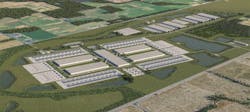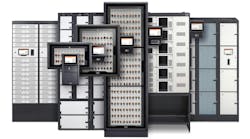Meta’s Dual-Track Data Center Strategy: Owning AI Campuses, Leasing Cloud, and Expanding Nationwide
Key Highlights
- Meta is investing heavily in AI-optimized data centers, including Hyperion in Louisiana and Prometheus in Ohio, to support advanced AI models and ambitions for artificial general intelligence.
- The Hyperion project involves complex power infrastructure, including a $4 billion gas plant and regional transmission upgrades, raising community and environmental concerns alongside sustainability efforts.
- Meta is adopting a dual strategy: building large, owned AI data centers while maintaining cloud partnerships, notably with Google, to meet immediate AI compute demands.
- Construction innovations like rapid deployment tents and on-site power generation are accelerating data center buildout, reflecting Meta’s focus on speed and efficiency.
- The company’s approach exemplifies a shift in the industry, blending ownership, leasing, and regional power projects to address the insatiable demand for AI compute capacity.
The question of who should own your AI Factory or data centers is a complex one. Recent news articles have pointed towards a trend among hyperscalers and large-scale information providers to lease their data centers, as we’ve seen the continued investment in the vendors that hyperscalers have traditionally partnered with to deliver new data center facilities. But a trend is starting to emerge where hyperscalers such as Meta want to own and control their infrastructure as much as possible.
Focus on Hyperion
An example of this is Meta’s latest data center project, code-named Hyperion. Hyperion is Meta’s next mega-scale, AI-optimized data center campus in northeast Louisiana. Mark Zuckerberg has described Hyperion as a multi-gigawatt cluster that will ultimately deliver around 5GW of “computational power,” and he’s compared the footprint of one of Meta’s new clusters to a “significant part of Manhattan.”
With approximately 2250 acres in Richland Parish Louisiana, and a planned 4 million square feet of buildings, this project will be Meta’s largest data center to date.
Construction on the project started at the end of 2024 and is expected to continue through 2030. Meta initially framed Louisiana as a 2 GW campus by the end of the decade, while later comments are positioning Hyperion to scale toward 5 GW of compute over time. Some reports have already surfaced that an interim milestone of 1.5 GW is being targeted by the end of 2027.
Hyperion will use this power to support Meta’s Superintelligence Labs and future model training. The superclusters being built in Louisiana and Ohio aim to power next-generation AI models and support ambitions for AGI via its Superintelligence Labs. By vertically integrating compute infrastructure, Meta seeks independence from public cloud providers, giving it cost control and speed.
Provisioning the Power is a Major Project All its Own
Powering a data center campus on this scale in an area like rural Louisiana is not a simple task. News reports and a utility commission filing by power company Entergy are starting to reveal the scope of project preparation already in process to get the site the power it will need.
To bring in outside power, Entergy plans a 100-mile, 500kV transmission project (at an approximate cost of $1.2 billion) to move bulk power into the area. Substations & lines tied to the site will include a new “Smalling” 500/230kV substation, a new “Car Gas Road” 500kV switchyard, six customer substations on Meta’s property, two 30-mile 500kV lines, and multiple 230kV feeders into the campus.
Additionally, Entergy has sought approval for three combined-cycle gas plants generating abou 2.25 GW of power and associated lines to meet the immediate load while broader transmission is built out; state hearings are underway with a vote on this part of the project expected before the end of August 2025.
Approval is being sought from the Louisiana Public Service Commision to build these three new gas plants and their associated infrastructure at a cost of just under $4 billion. Concerns are being raised by local community groups as well as the Union of Concerned Scientists (UCS) and Louisiana-based Alliance for Affordable Energy (AAE) not just about how much of the initial costs will be passed on to Louisiana ratepayers, but also on issues related to what happens as the first series of contracts for power begin to expire in 15 years.
The plans being presented were initially scheduled to be voted on in October 2025 and the fast tracking of project approval has highlighted the concerns of the opposition. Both the short- and long-term impacts of the power development projects have drawn concern from opposition groups, with the key message being that there are insufficient protections for the local ratepayers and guarantees from Meta.
Much of the local media coverage has highlighted that Hyperion is projected to draw ~2 GW by 2030, with potential to scale, and that Entergy’s proposals, including the aforementioned new gas units alongside planned renewables, continue to raise familiar debates about water use, emissions, and rate impacts. To address sustainability issues being raised for the Richland Parish campus, Meta has emphasized efficient cooling design, on-site stormwater capture, and water-saving fixtures, consistent with the company’s broader water-positive by 2030 goal
Beyond simply getting developmental approval from the state, Meta and Entergy say they will add enough clean energy to cover 100% of the data center’s use, with at least ~1,500 MW of new renewables planned. This includes potential use of new nuclear power in the future.
Meta’s public commitments to powering these projects with renewable energy are challenged by real-world constraints. While Meta has agreements for 1.8 GW of solar and wind, 150 MW geothermal, and even nuclear power extensions, most current power is set to come from gas.
Much of the design and process for Hyperion is based on the current Prometheus project that Meta is building in Ohio.
What Is Prometheus?
Prometheus is Meta’s first “titan” AI supercluster. This is a multi-GW campus purpose-built for training and serving large AI models as part of Meta’s superintelligence push. Mark Zuckerberg has said Prometheus is due online in 2026, with additional titan clusters (including Hyperion) following.
Prometheus is being built in New Albany, Ohio, where Meta has had a presence since 2017 on the New Albany International Business Park campus, making ujse of a 740 acre industrial tract.
The announcement that the company would be using tent-like structures during the initial Prometheus build-out did raise a few eyebrows. These tents are aluminum structures that use a weatherproof fabric covering to allow rapid construction. Meta refers to these tents as “rapid deployment structures” which will enable faster data center buildout.
Power Behind the Meter Meets Regional Transmission Upgrades
Meta is also taking a somewhat different approach to power for Prometheus, where significant behind the meter power generation is planned, as Ohio regulators approved Socrates South, a 200 MW natural-gas project to directly serve Meta’s campus.
Ohio PUC filings describe Will-Power (a Williams Cos. subsidiary) as builder/operator, with two 24-inch pipelines supplying the plant. The docket outlines two 200 MW generation sites at full buildout , for an eventual 400 MW of behind-the-meter capacity, with the first site targeted for Q3 2026 completion.
The campus is also dependent on regional transmission upgrades in the PJM footprint led by AEP affiliates; PJM has approved ~$1.7B of AEP transmission projects to move more power into Central Ohio amid rapid data-center growth.
While we’ve previously reported on AEP’s aggressive power generation efforts, you still need to get power to your build sites, and AEP Ohio has said it will take 7–10 years for transmission to fully catch up. This interim on-site generation reduces grid impact while those upgrades are built.
Who’s Footing the Bill?
While we’ve discussed the price tag for the power needed for Hyperion, the buildout of the infrastructure itself is expected cost in the $10 billion range. Reports has emberged that Meta was seeking $29 billion in financing, and as of the middle of August 2025 it appears to have found the money, with up to $3 billion in equity and $26 billion in debt. Pacific Investment Management Company (PIMCO) will handle $26 billion in debt while Blue Owl Capital contributes $3 billion in equity, with Morgan Stanley orchestrating the process.
Meta is moving from data center leasing to ownership and co-development of AI-focused facilities. The structure mirrors strategies by Amazon and Microsoft and allows Meta to pave its infrastructure path without publicly increasing debt burden. Though with a last reported revenue of $165 billion annually the fact that Meta has committed to a an announced 2025 CAPEX of $64–72 billion, up significantly from the $37 billion spent in 2024, reflects the seriousness of these AI data center projects to the future well-being of the business.
Kansas City: A Traditional Data Center Milestone
At the same time, Meta continues to expand its conventional data center fleet. On August 20, the company announced that its $1 billion Kansas City data center is now online and serving traffic. First launched in 2022, the Missouri facility represents the latest operational node in Meta’s global infrastructure that underpins billions of daily connections across its platforms.
The project reflects Meta’s standard playbook for scale-out capacity: a multi-year construction effort involving more than 1,500 skilled trade workers at peak, transitioning to over 100 long-term operations jobs. It has also served as an economic driver for the community, sourcing most construction materials domestically and directing more than $1 million in grants to local schools and nonprofits across Clay and Platte counties, as well as Kansas City itself.
Sustainability features were central to the design. The campus has achieved LEED Gold certification, integrates advanced water-efficient cooling, and captures stormwater on-site to reduce potable water use, saving over a million gallons during construction alone. As with all of Meta’s data centers, its electricity use is matched with 100% renewable energy.
Beyond infrastructure, Meta is using the project as a platform for community engagement. Initiatives include Community Accelerator events for small businesses on how to apply AI tools like Meta AI, and ongoing Data Center Community Action Grants that support local technology, education, and workforce programs.
While not AI-optimized like the forthcoming Prometheus and Hyperion campuses, the Kansas City site is part of the continuum. It provides immediate capacity while Meta readies its next generation of AI-specific designs, the first of which is scheduled to come online in 2026. In this sense, Kansas City illustrates how Meta is balancing near-term scale with long-term transformation.
Bridging Capacity with Google Cloud
Even as Meta invests billions to own and operate AI-optimized data centers like Hyperion and Prometheus, it continues to rely on external cloud infrastructure to meet immediate needs. Just days before its Kansas City opening, Meta signed a six-year agreement with Google Cloud valued at more than $10 billion, according to news reports.
The deal underscores how urgent AI compute demand has become. Meta, long reliant on AWS and also a customer of Microsoft Azure, will now lean on Google’s infrastructure to support AI model training and deployment. For Google, the contract marks a marquee win in its effort to compete with Amazon and Microsoft for hyperscale cloud deals.
For Meta, the agreement provides critical interim capacity while its massive Louisiana and Ohio projects remain under construction. As one source told CNBC, the Google deal is “mainly around artificial intelligence infrastructure,” signaling that Meta is tapping every available path to keep its Llama models and AI-driven services on track during this infrastructure transition.
Conclusion: A Dual-Track Strategy for Meta’s Future
Taken together, the moves highlight a dual-track strategy. On one hand, Meta is investing tens of billions to own and operate a new class of AI-optimized data centers, anchored by Prometheus in Ohio and Hyperion in Louisiana. On the other, it is still leaning on leased cloud capacity from rivals like Google, while continuing to commission conventional campuses such as Kansas City.
This layered approach reflects the urgency and volatility of the AI era. Compute demand is outpacing the ability to deliver power and infrastructure, forcing hyperscalers to hedge their bets across multiple models: long-term ownership, short-term leasing, and incremental buildouts.
What happens in Louisiana and Ohio will be closely watched across the sector. If Meta succeeds in pairing multi-gigawatt campuses with massive transmission and generation projects, it may reset the template for how hyperscale AI infrastructure is developed — vertically integrated, power-secure, and financed at unprecedented scale. But Meta’s parallel reliance on cloud competitors underscores that no single strategy is sufficient on its own in the current market.
For the data center industry, the message is clear: the AI build cycle is not just accelerating, it is fragmenting into new forms. Hyperscalers will need to mix ownership, partnerships, and cloud capacity in ways that blur old boundaries. As Meta’s experience shows, the winners will be those who can align real estate, energy, and financing fast enough to keep pace with the insatiable appetite of artificial intelligence.
At Data Center Frontier, we talk the industry talk and walk the industry walk. In that spirit, DCF Staff members may occasionally use AI tools to assist with content. Elements of this article were created with help from OpenAI's GPT5.
Keep pace with the fast-moving world of data centers and cloud computing by connecting with Data Center Frontier on LinkedIn, following us on X/Twitter and Facebook, as well as on BlueSky, and signing up for our weekly newsletters using the form below.
About the Author

David Chernicoff
Matt Vincent
A B2B technology journalist and editor with more than two decades of experience, Matt Vincent is Editor in Chief of Data Center Frontier.




